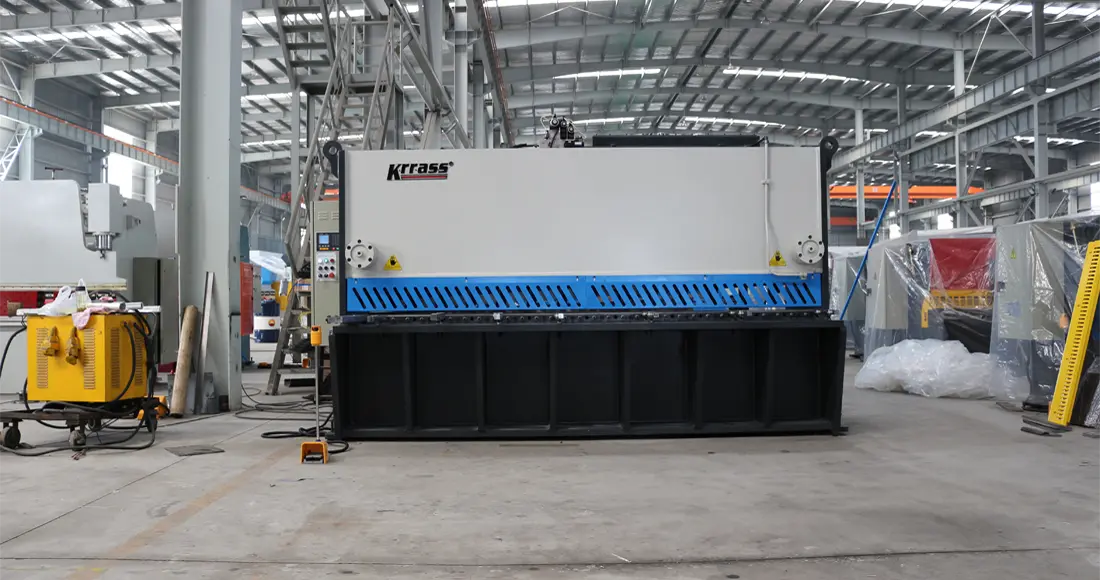The blades of the shearing machines are the knives used to cut sheet metal or other hard materials. These blades are usually made of high-hardness alloy steel or materials such as tungsten carbide to ensure their wear resistance and cutting ability.
The items and requirements for inspecting the welding quality of the shearing machine’s blade are as follows:
- Check weld strength: Grind the back of knife with a green silicon carbide grinding wheel to check the thickness of the solder layer, the thickness is required to be less than 0.15mm. There should be no porosity and insufficient solder on the bottom surface of the tip support, and the weld that is not filled with solder should not be greater than 10% of the total length of the weld. If there are pores, the blade will fall off when cutting.
- Check the position of the blade in the slot: if the blade is misaligned and sagging beyond the technical requirements, reweld the blade of cutting machine.
- Check the welding strength: hit the blade with a medium force with a wood or copper hammer, or hit the tool bar with a strong force with a hammer, and it is qualified if the blade does not fall out of the knife slot. Check the welding strength of the blade, not one by one, but spot check.
- Check the flatness of the blade: If there are obvious pits on the blade, it indicates that the blade is overheated and deformed, and you should burn and weld a new blade.
Check for cracks: After the blade is cleaned by kerosene, if the blade of the shearing machine has cracks, the kerosene seeps into the cracks, creating black lines that can be seen with the naked eye. It can also be viewed with a 10-40x magnifying glass.
Due to the different types of hydraulic shearing machines on the market, it can be difficult to decide which one is the best for your needs. But don’t worry, KRRASS are here to help!
Request a callback
Visit our product
Checking the blade cracks can use color detection method: using 65% kerosene, 30% transformer oil and 5% turpentine mixed into the solution, add a little Sudan red. Place the part of the turning tool blade in the solution for 10-15 minutes, and then wash it with clean water, coat it with a layer of white earth (kaolin), and observe the surface after baking. If there are cracks on the blade, the color of the solution will be revealed on the white soil and can be seen with the naked eye. Cracked blades cannot be used and need to be re-welded.
- Remove the lower blade and clean it piece by piece.
- The blade can be used on all sides, and the good side is selected and fitted tightly. Check the flatness of the blade in both horizontal and vertical directions.
- Remove the top blade and clean it piece by piece. Similarly, the blade can be used on all sides, and the good side can be tightly installed. Check the flatness of the blade in both horizontal and vertical directions.
- The upper blade is fixed and can not be adjusted. We adjust the blade clearance of the shearing machine by adjusting the lower blade.
- Find the lower blade on the left and right of the two wide gap screws generally on the outside.
- Find the left and right of the lower blade to push the lower blade to reduce the gap of the setting screw, it has a locking spare nut, which is usually inside.
- Loosen the left and right bolts of the lower blade table.
- Manual turning will lower the upper blade to the appropriate position, the operator to the shearing machine blanking area began to adjust.
- Use the feeler ruler to start from the unoccluded part of the upper and lower blade of the left hand to roughly adjust to 0.5 mm.
- Manually turn the blade up to the middle position and adjust it to 0.5 mm.
- Manually turn the blade up to the right position where the upper and lower knives are not removed and the middle position is adjusted to 0.5 mm.
- Manually turn the upper blade down to the appropriate position and start fine adjustment.
- Use the feeler ruler to fine-tune the feeler ruler from the upper and lower blade of the left hand to the point where the three wires can enter and the five wires cannot enter.
- Manual turning makes the blade move up to the middle position and start to fine adjust to the feeler ruler three wires can enter five wires can not enter.
- Manual turning makes the blade move up to the position on the right side where the upper and lower knives are not removed. Fine-tune the feeler ruler until three wires can enter and five wires cannot enter.
- The above is for the new car fine adjustment to the ruler three wires can enter five wires can not enter.
- For old cars, fine-tune the feeler to ten threads that can enter and twenty threads that cannot enter. Or adjust it according to the required sheet metal thickness of 1/10- 1/20 .
- When the edge of the cutting machine is sharp, such as the edge of the cutting plate has burrs, the gap between the upper and lower blades can be appropriately reduced.
Request a callback
Visit our product
Visit our Youtube channel
Which hydraulic shearing machine is right for you?
If you need any questions answered or to discuss your hydraulic shearing machine requirements for your unique business, please contact us today on 0086 18952087956 or using our online contact form.





